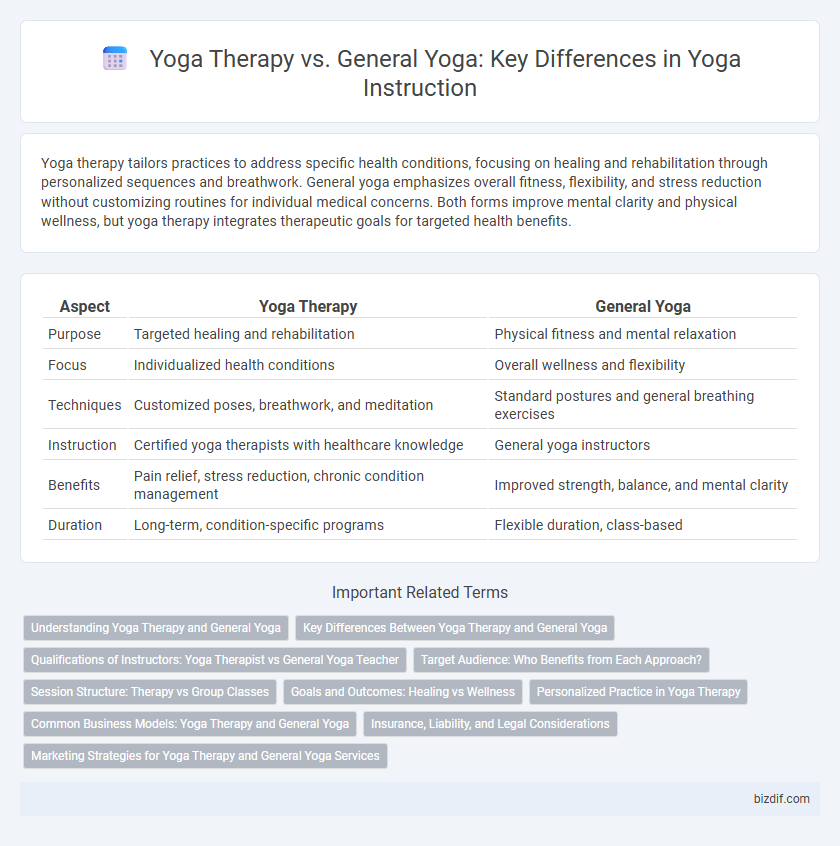Yoga therapy tailors practices to address specific health conditions, focusing on healing and rehabilitation through personalized sequences and breathwork. General yoga emphasizes overall fitness, flexibility, and stress reduction without customizing routines for individual medical concerns. Both forms improve mental clarity and physical wellness, but yoga therapy integrates therapeutic goals for targeted health benefits.
Table of Comparison
| Aspect | Yoga Therapy | General Yoga |
|---|---|---|
| Purpose | Targeted healing and rehabilitation | Physical fitness and mental relaxation |
| Focus | Individualized health conditions | Overall wellness and flexibility |
| Techniques | Customized poses, breathwork, and meditation | Standard postures and general breathing exercises |
| Instruction | Certified yoga therapists with healthcare knowledge | General yoga instructors |
| Benefits | Pain relief, stress reduction, chronic condition management | Improved strength, balance, and mental clarity |
| Duration | Long-term, condition-specific programs | Flexible duration, class-based |
Understanding Yoga Therapy and General Yoga
Yoga therapy tailors practices to individual health conditions, integrating meditation, breathwork, and physical postures to address specific medical or psychological needs. General yoga emphasizes overall physical fitness, flexibility, and stress reduction through standardized sequences suitable for a broad audience. Understanding the distinction highlights yoga therapy's clinical focus versus general yoga's emphasis on general wellness and fitness.
Key Differences Between Yoga Therapy and General Yoga
Yoga therapy is tailored to address specific health conditions by integrating personalized assessment and therapeutic techniques, whereas general yoga emphasizes overall fitness, flexibility, and stress reduction through standard practice routines. Yoga therapy often involves collaboration with healthcare professionals to create customized treatment plans targeting physical, mental, or emotional issues, while general yoga classes typically follow a one-size-fits-all approach. The key difference lies in yoga therapy's clinical focus on healing and rehabilitation compared to the broader wellness goals of general yoga.
Qualifications of Instructors: Yoga Therapist vs General Yoga Teacher
Yoga therapists hold advanced certifications and often require backgrounds in health or psychology, ensuring specialized knowledge in addressing physical and mental health conditions through tailored yoga practices. General yoga teachers typically complete foundational training programs focused on broad yoga styles and techniques without the clinical emphasis present in therapy training. The distinction in qualifications enables yoga therapists to design personalized therapeutic interventions, while general yoga teachers guide practices aimed at general wellness and fitness.
Target Audience: Who Benefits from Each Approach?
Yoga therapy targets individuals with specific health conditions such as chronic pain, anxiety, or mobility issues, offering personalized sessions tailored to medical needs. General yoga suits those seeking overall wellness, flexibility, and stress reduction through standardized practices in group settings. Both approaches benefit diverse populations, but yoga therapy emphasizes therapeutic outcomes for clinical or rehabilitative goals.
Session Structure: Therapy vs Group Classes
Yoga Therapy sessions are tailored to individual needs, focusing on specific health conditions with personalized assessments and customized practices. General yoga group classes follow a standardized structure designed for broad audiences, emphasizing overall fitness and flexibility. The therapeutic approach incorporates ongoing evaluation and adaptive sequences, whereas group classes maintain a consistent flow suitable for various skill levels.
Goals and Outcomes: Healing vs Wellness
Yoga therapy targets specific health conditions to promote healing and recovery through tailored practices, addressing physical, mental, and emotional ailments. General yoga emphasizes overall wellness, enhancing flexibility, strength, and mental clarity for healthy individuals. The primary goal of yoga therapy is symptom relief and rehabilitation, while general yoga focuses on maintaining balance and preventing illness.
Personalized Practice in Yoga Therapy
Yoga therapy emphasizes a personalized practice tailored to individual health conditions, unlike general yoga that follows a standardized routine. Certified yoga therapists assess physical, mental, and emotional needs to design specific sequences promoting healing and well-being. This customized approach enhances therapeutic outcomes by addressing unique limitations and goals for each client.
Common Business Models: Yoga Therapy and General Yoga
Yoga therapy often operates on a personalized, one-on-one session model emphasizing tailored treatment plans to address specific health conditions, which can command higher fees and typically requires certified therapy credentials. General yoga businesses commonly adopt group class formats, memberships, and drop-in rates, focusing on broader wellness and fitness goals with scalable class sizes and varied price points. Both models may incorporate workshops and retreats, but yoga therapy prioritizes clinical outcomes, whereas general yoga emphasizes community and lifestyle benefits.
Insurance, Liability, and Legal Considerations
Yoga therapy involves personalized treatment plans tailored to address specific health conditions, often requiring professional liability insurance to manage risks associated with therapeutic interventions. General yoga instruction focuses on overall wellness and physical fitness, typically covered under broader liability policies with fewer legal complexities. Insurance providers may differentiate coverage terms, premiums, and compliance requirements based on whether the yoga practice is labeled therapeutic or general, impacting both instructors and clients.
Marketing Strategies for Yoga Therapy and General Yoga Services
Marketing strategies for Yoga Therapy emphasize showcasing its personalized, health-focused benefits targeting individuals with specific medical conditions, often collaborating with healthcare providers and using testimonials to build trust. General Yoga marketing highlights broad wellness, stress relief, and fitness benefits, leveraging community events, social media challenges, and visually appealing content to attract a wide audience. Tailoring messaging to address the unique needs and goals of each segment increases engagement and conversions in both Yoga Therapy and General Yoga services.
Yoga Therapy vs General Yoga Infographic

 bizdif.com
bizdif.com